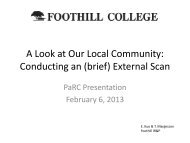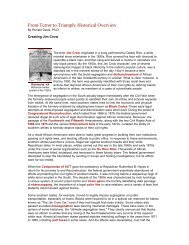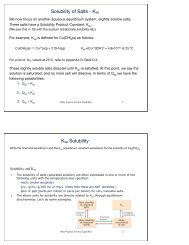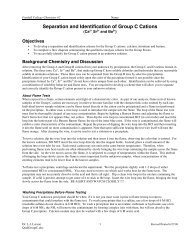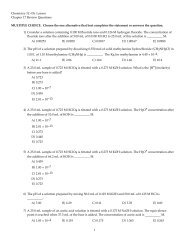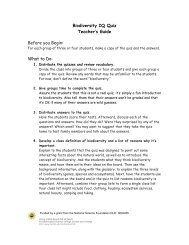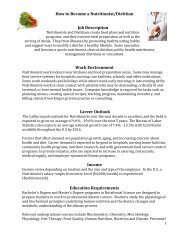General Psychology Article Analysis 2: Change ... - Foothill College
General Psychology Article Analysis 2: Change ... - Foothill College
General Psychology Article Analysis 2: Change ... - Foothill College
You also want an ePaper? Increase the reach of your titles
YUMPU automatically turns print PDFs into web optimized ePapers that Google loves.
<strong>General</strong> <strong>Psychology</strong><br />
<strong>Article</strong> <strong>Analysis</strong> 2: <strong>Change</strong> Blindness<br />
75 Points<br />
Your paper should be written in the following format: Times New Roman, 12pt font, 1” margins,<br />
double-spaced<br />
Use information from the Powerpoint slides, your text, and the article to answer the following questions.<br />
Your answers should be thorough yet concise. Your answers will be assessed on their accuracy and depth<br />
of thought. I’m looking for cogent (well-organized) reasoning and arguments, and thoughtful connections<br />
between the material covered in class/your text, real life, and the article.<br />
There is no specific page limit. Just make sure that you are answering the questions thoroughly and fully.<br />
But keep in mind, longer answers don’t necessarily mean better answers.<br />
Write all answers using your own words. Evidence of plagiarism will result in a grade of “0” for<br />
the assignment<br />
*The article has been edited for the purpose of pertaining to relevant class material<br />
Questions<br />
1. Thoroughly explain the concept of change blindness. (5 pts)<br />
2. What is(are) the main purpose(s) of this research? (5 pts)<br />
3. Provide a brief summary of the procedure from Experiment 1. (5pts)<br />
4. Summarize the results from Experiment 1. What are the author’s propositions for the reasons that<br />
younger people were able to more accurately identify a change? How is this reasoning supported by the<br />
procedure and results of Experiment 2? (10pts)<br />
5. A textbook author is writing a new social psychology textbook and has asked you to write a short piece<br />
for her new book (that would appear in one of the “Featured Topics” section in the chapter). She explains<br />
that although the goal of this study was to examine change blindness, she wants you to provide an<br />
analysis for the ways in which the findings of this study apply to social psychology. Thus, she wants you<br />
to explain how the findings from this study explain not only change blindness, but also help explain the<br />
ways in which people think about other people in real life. Thus, provide your own analysis for how the<br />
findings from this study, particularly those regarding in-groups and out-groups, can apply to other aspects<br />
of social cognition. Your are free to structure your analysis any way you would like, but your response<br />
must integrate two of the following terms:<br />
Cognitive dissonance<br />
Implicit biases<br />
Stereotypes<br />
Attribution<br />
Attitudes (affective, cognitive, behavioral) (25 pts)<br />
6. Personal response: What is your reaction to this article and its conclusions? Do you find yourself<br />
categorizing people into in and out-groups? If so, is that a good or bad thing? (10pts)<br />
7. Argue for or against: Do you think the fundamental attribution error contributes to prejudice and<br />
discrimination. To answer this question provide a thorough explanation of the fundamental attribution<br />
error. Explain all aspects of your reasoning and provide an example that is relevant to your life. (15pts)
Failure to detect changes to people<br />
during a real-world interaction<br />
DANIEL J. SIMONS<br />
Harvard University, Cambridge, Massachusetts<br />
and<br />
DANIEL T. LEVIN<br />
Kent State University, Kent, Ohio<br />
Despite our impression that we retain the visual details of<br />
our surroundings from one view to the next, we are<br />
surprisingly unable to detect changes to such details.<br />
Recently, experiments from a number of laboratories have<br />
shown that people fail to detect substantial changes to<br />
photographs of objects and real-world scenes when the<br />
ability to detect retinal differences is eliminated<br />
(Blackmore, Brelstaff, Nelson, & Troscianko, 1995;<br />
Grimes, 1996). That is, when retinally localizable<br />
information signaling a change is masked by an eye<br />
movement or a flashed blank screen, observers have<br />
difficulty detecting changes to the visual details of a scene.<br />
These findings of “change blindness” suggest that<br />
observers lack a precise visual representation of their<br />
world from one view to the next. Although we have known<br />
for some time that memory for scenes is often distorted,<br />
sometimes quite sparse, subject to suggestions, and<br />
influenced by expectations and goals (Bartlett,1932/1977;<br />
Brewer & Treyens, 1981; Loftus, 1979), studies of change<br />
blindness suggest that such details may not be retained<br />
even from one instant to the next (Bridgeman & Mayer,<br />
1983; Dennett, 1991).<br />
Given the richness of our visual world, it is<br />
perhaps unsurprising that we cannot represent all the visual<br />
details of every object and instead must focus on a few<br />
important objects. Recent models of attention have argued<br />
that observers can fully represent the details of only a few<br />
centrally attended objects in a scene. For example, models<br />
based on object files (e.g., Treisman, 1993) suggest that<br />
we can simultaneously represent several distinct objects in<br />
our environment, updating our representations for changes<br />
in their properties and features. Such models suggest the<br />
possibility that representations of centrally attended<br />
objects are relatively detailed even if those for peripheral<br />
objects are not.<br />
Thus, attention appears to play a significant role in<br />
the change detection process. As predicted by models of<br />
object files, changes to objects that independent raters<br />
consider to be the center of interest of a scene are detected<br />
in significantly fewer alternations than changes to<br />
peripheral objects. That is, changes to the details of<br />
attended objects are detected more readily. Clearly,<br />
focused attention to an object is helpful and possibly<br />
necessary for change detection, as evidenced by such<br />
“center of interest” effects (O’Regan, Rensink, &<br />
Clark, 1996; Rensink et al., 1997; Tarr & Aginsky, 1996,<br />
July) and by findings of more successful change detection<br />
when explicit cues specify the location or the type of<br />
change (Aginsky, Tarr, & Rensink, 1997).<br />
However, attention may not be sufficient for<br />
change detection. In fact, observers often fail to detect<br />
changes even when attention is focused directly on the<br />
changing object (Levin & Simons, 1997; O’Regan et al.,<br />
1997; Simons, 1996). In a recent series of studies, we used<br />
motion pictures to directly examine the ability to detect<br />
changes to attended objects (Levin & Simons, 1997).<br />
These brief motion pictures depicted a simple action<br />
performed by a “single” actor. During the film, the actor<br />
was replaced by a different person. For example, in one<br />
film an actor walked through an empty classroom and<br />
began to sit in a chair. The camera then changed, or “cut,”<br />
to a closer view and a different actor completed the action.<br />
Even though the actors were easily discriminable and were<br />
the focus of attention, only 33% of the 40 participants<br />
reported noticing the change from one actor to another<br />
(Levin & Simons, 1997). Although the motion picture<br />
experiments demonstrate that attention alone is not<br />
sufficient for a complete representation of the visual<br />
details of an object, they do not fully assess our ability to<br />
represent objects in the real world. Motion picture<br />
perception is similar in many ways to perception in the real<br />
world, but motion pictures are still a subset of a complete<br />
visual experience (Arnheim, 1933/1966). Most<br />
importantly, they are viewed passively and may not<br />
completely engage the processes necessary for a complete<br />
representation of attended objects.<br />
Can people more fully represent the details of a<br />
scene when they are direct participants, interacting with<br />
the objects in the real world. Here we assess this<br />
possibility by taking the study of change blindness into the<br />
real world. Rather than changing the sole actor in a video,<br />
we changed the subjects’ conversation partner during a<br />
typical daily interaction.<br />
EXPERIMENT 1<br />
In Experiment 1, we created a situation that allowed us to<br />
surreptitiously substitute one individual for another in the<br />
middle of a natural, real-world interaction. The situation<br />
we chose was asking directions of a pedestrian on a<br />
college campus.1We temporarily interrupted this<br />
interaction by carrying a door between the experimenter<br />
and the pedestrian. While the experimenter was occluded<br />
by the door, another experimenter took his place and<br />
continued the interaction after the door had passed. If<br />
change detection failures are based on the passive nature<br />
of mediated stimuli, these substitutions should be clearly<br />
detectable.<br />
Method<br />
Subjects. A total of 15 pedestrians were approached on the<br />
campus of Cornell University. They ranged in approximate<br />
age from 20 to 65. Only pedestrians walking alone or<br />
together with one other person (two cases) were<br />
approached.
Procedure. An experimenter carrying a campus map<br />
asked unsuspecting pedestrians for directions to a nearby<br />
building (see Figure 1a). Pedestrians had a clear view of<br />
the experimenter starting from a distance of approximately<br />
20 m as they walked down a sidewalk. After the<br />
experimenter and pedestrian had been talking for 10–15<br />
sec, two other experimenters carrying a door rudely passed<br />
between them. As the door passed, the first experimenter<br />
grabbed the back of the door, and the experimenter who<br />
had been carrying that part of the door stayed behind and<br />
continued to ask for directions (Figure 1c). The first<br />
experimenter kept his map during the interruption, and the<br />
second experimenter produced an identical copy of the<br />
map after the door passed. The door blocked the<br />
pedestrian’s view for approximately 1 sec (Figure 1b).<br />
From the subject’s perspective, the door briefly occluded<br />
his/her conversation partner, and when it was gone, a<br />
different person was revealed. As the door passed, subjects<br />
typically made eye contact with the second experimenter<br />
before continuing to give directions.2 The entire<br />
interaction took 2–5 min. The two experimenters wore<br />
different clothing and differed in height by approximately<br />
5 cm (Figure 1d). Their voices were also clearly<br />
distinguishable.<br />
After a pedestrian finished giving directions, the<br />
experimenter told him/her, “We’re doing a study as part of<br />
the psychology department [experimenter points to the<br />
psychology building next door] of the sorts of things<br />
people pay attention to in the real world. Did you notice<br />
anything unusual at all when that door passed by a minute<br />
ago?” Responses were noted by the experimenter, and if<br />
subjects failed to report the change, they were directly<br />
asked, “Did you notice that I’m not the same person who<br />
approached you to ask for directions?” After answering<br />
this question, all subjects were informed about the purpose<br />
of the experiment.<br />
Results and Discussion<br />
If change blindness results from the passive nature of<br />
mediated stimuli, then these real-world substitutions<br />
should be detected. When asked if they had noticed<br />
anything unusual, most pedestrians reported that the<br />
people carrying the door were rude. Yet, despite clear<br />
differences in clothing, appearance, and voice, only 7 of<br />
the 15 pedestrians reported noticing the change of<br />
experimenters. Those who did not notice the change<br />
continued the conversation as if nothing had happened (in<br />
fact, some pedestrians who did notice the change also<br />
continued the conversation!). Pedestrians who did not<br />
notice the change were quite surprised to learn that the<br />
person standing in front of them was different from the one<br />
who initiated the conversation. One pedestrian who<br />
reported noticing nothing unusual nonetheless claimed to<br />
have noticed the change when asked directly.<br />
Interestingly, those who noticed the change were<br />
all students of roughly the same age as the experimenters<br />
(approximately 20–30 years old). Those who failed to<br />
detect the change were slightly older than the<br />
experimenters (approximately 35–65 years old). One<br />
possible explanation for this difference is that younger<br />
pedestrians were more likely to expend effort encoding<br />
those features that would differentiate the experimenters<br />
because the experimenters were roughly of their own<br />
generation. In contrast, older pedestrians would likely<br />
encode the experimenters without focusing on features that<br />
could differentiate the two of them, instead viewing them<br />
as members of a social group other than their own. This<br />
hypothesis draws on findings from social psychology that<br />
members of one’s own social group (“in-group”) are
treated differently from members of social groups<br />
distinctly apart from one’s own (“out-group”). Upon<br />
encountering a member of an in-group, people tend to<br />
focus attention on individuating features and to pay little<br />
attention to the person’s social-group membership. In<br />
contrast, for members of out-groups, people direct more<br />
attention to attributes associated with the out-group as a<br />
whole and generally do not focus on features that<br />
distinguish one individual from others in the group (see,<br />
e.g., Rothbart & John, 1985). These differences in<br />
processing of members of in-groups and out-groups extend<br />
to many aspects of cognition. For example, people are<br />
likely to assume that members of out-groups are<br />
collectively less variable on a variety of traits and<br />
variables (Judd & Park, 1988; Linville, Fischer, &<br />
Salovey, 1989). This tendency to code group-specifying<br />
information for members of out-groups can even<br />
determine what represents a visual feature for a particular<br />
category (Levin, 1996). Applying these differences in the<br />
coding of in-groups and out-groups to the findings of<br />
Experiment 1, we hypothesize that the younger subjects<br />
considered themselves members of the same social group<br />
as the experimenters and older subjects considered the<br />
experimenters to be members of an out-group. To test this<br />
hypothesis, we changed the appearance of the<br />
experimenters so that they could be classified as members<br />
of an out-group by the younger subjects.<br />
EXPERIMENT 2<br />
To examine the role of social group membership in the<br />
detection of changes, a second experiment was conducted<br />
using the same procedure as the first, but with one critical<br />
change: The same two experimenters dressed as<br />
construction workers (see Figure 2). The experimenters<br />
again wore different clothing: One wore a construction hat<br />
with writing on the front, a large tool belt, and a light blue<br />
shirt, and the other wore a newer hat without writing, no<br />
tool belt, and a black shirt. The experiment was conducted<br />
in the same location as Experiment 1, which happened to<br />
be approximately 50 m from a construction site. As in<br />
Experiment 1, an experimenter approached a pedestrian to<br />
ask for directions to a building on campus. During the<br />
conversation, the experimenters were switched. Unlike in<br />
the first experiment, all 12 pedestrians who participated in<br />
Experiment 2 were from the younger age group (Cornell<br />
graduate or undergraduate students), the group that had<br />
always detected the change in Experiment 1. The questions<br />
asked of the subjects were identical to those of Experiment<br />
1 except that subjects were informed immediately after<br />
providing directions that the experimenters were not<br />
actually construction workers but were doing a study as<br />
part of the psychology department.<br />
Results and Discussion<br />
In contrast to the younger pedestrians in Experiment 1, all<br />
of whom noticed the change, only 4 of the 12 pedestrians<br />
in Experiment 2 reported noticing the switch when asked if<br />
they had seen anything unusual. Five subjects failed to<br />
report the change and were surprised to learn of the switch.<br />
An additional 3 subjects reported noticing nothing unusual<br />
but then claimed to have noticed the switch of<br />
experimenters. Unlike pedestrians who clearly noticed the<br />
change, these 3 pedestrians could not accurately describe<br />
any of the differences between the experimenters,<br />
suggesting that the demands of the task led them to report<br />
noticing the change even though they probably had not.
Thus, subjects from the same age group that had<br />
successfully detected the change in Experiment<br />
1 detected it only 33% of the time in Experiment 2.<br />
When the experimenters appeared to be members of an<br />
out-group, thereby decreasing the likelihood that students<br />
would code individuating features, the ability to detect a<br />
change to the centrally attended object in a scene was<br />
dramatically reduced. One subject who failed to detect the<br />
change essentially stated our predicted hypothesis: She<br />
said that she had just seen a construction worker and had<br />
not coded the properties of the individual. That is, she<br />
quickly categorized the experimenter as a construction<br />
worker and did not retain those features that would allow<br />
individuation. Even though the experimenter was the<br />
center of attention, she did not code the visual details and<br />
compare them across views. Instead, she formed a<br />
representation of the category, trading the visual details of<br />
the scene for a more abstract understanding of its gist or<br />
meaning.<br />
GENERAL DISCUSSION<br />
These simple experiments build on classic findings of<br />
failures of eyewitness identification (e.g., Loftus, 1979)<br />
and distortions in memory (Bartlett, 1932/1977) as well as<br />
recent demonstrations of change blindness for objects<br />
(Pashler, 1988; Phillips, 1974; Simons, 1996), photographs<br />
(Aginsky et al., 1997; Grimes, 1996; O’Regan et al., 1996;<br />
Rensink et al., 1997), and motion pictures (Levin &<br />
Simons, 1997; Simons, 1996; Simons & Levin, 1997). Yet,<br />
unlike earlier demonstrations, this experiment shows that<br />
people may not notice changes to the central object in a<br />
scene even when the change is almost instantaneous and<br />
happens in the middle of an ongoing, natural event.<br />
Attention alone does not suffice for change detection, even<br />
in the real world. Instead, successful change detection<br />
probably requires effortful encoding of precisely those<br />
features or properties that will distinguish the original from<br />
the changed object.<br />
One potential objection to our results derives from<br />
the pragmatics of the interaction. Specifically, subjects<br />
may have detected the change but the social demands of<br />
the situation precluded them from reporting it. This<br />
possibility is substantially diminished by the subjects in<br />
each experiment who reported noticing nothing unusual<br />
but then reported noticing the switch. Although these<br />
subjects probably did not notice the change, the social<br />
demands of the situation encouraged them to report having<br />
noticed the switch when asked directly. Thus, the demands<br />
of the situation seem biased to increase reports of the<br />
switch rather than to decrease them.<br />
Another possible objection is that the task of<br />
giving directions distracted subjects from focusing their<br />
attention on the experimenters. That is, subjects were<br />
focused on the map rather than their conversational<br />
partner. Anecdotally at least, subjects appeared focused on<br />
the interaction and the conversation, often making eye<br />
contact with the experimenters, hearing their voices, and<br />
taking turns in a conversation. Although we believe the<br />
results are not specific to this situation, ongoing<br />
experiments using a different type of interaction are<br />
directly examining the possible distraction caused by the<br />
map and possible disruptions to the representation of the<br />
first experimenter caused by the unusual nature of the<br />
interruption.<br />
A more fundamental question involves assessing<br />
the similarity of the experimenters. Clearly, no one would<br />
be surprised if pedestrians failed to notice a substitution of<br />
identically dressed identical twins. The inability to notice<br />
small changes is unsurprising because such changes<br />
naturally occur between views. For example, people rarely<br />
notice variation in the position and orientation of moveable<br />
objects such as body parts (Levin & Simons, 1997). If we<br />
constantly noticed such changes, they would likely detract<br />
from our ability to focus on other, more important aspects<br />
of our visual world. <strong>Change</strong> detection as a method relies<br />
on the tendency of our visual system to assume an<br />
unchanging world. The fact that we do not expect one<br />
person to be replaced by another during an interaction may<br />
contribute to our inability to detect such changes. A critical<br />
question for future research is why some changes are more<br />
likely to be detected than others. Clearly we would be<br />
quite surprised if subjects missed a switch between<br />
enormously different people (e.g., a switch from a 4 ft 9 in.<br />
female of one race to a 6 ft 5 in. male of another). The<br />
change in this case would alter not only the visual details<br />
of the person, but also their category membership. If, as<br />
suggested by other recent findings of change blindness, we<br />
retain only abstracted information and not visual details<br />
from one view to the next, changes to category<br />
membership may well be detectable. Abstraction of<br />
category information is clearly central to coding other<br />
people (e.g., the effects of in-group and out-group<br />
discussed earlier) and may underlie the representation of<br />
other objects across views as well.<br />
In our experiments, the change from one<br />
experimenter to another met all of these criteria. Yet, a<br />
substantial number of pedestrians failed to detect the<br />
switch. Taken together, these experiments show that even<br />
substantial changes to the objects with which we are<br />
directly interacting will often go unnoticed. Our visual<br />
system does not automatically compare the features of a<br />
visual scene from one instant to the next in order to form a<br />
continuous representation; we do not form a detailed visual<br />
representation of our world. Instead, our abstract<br />
expectations about a situation allow us to focus on a small<br />
subset of the available information that we can use to<br />
check for consistency from one instant to the next.




